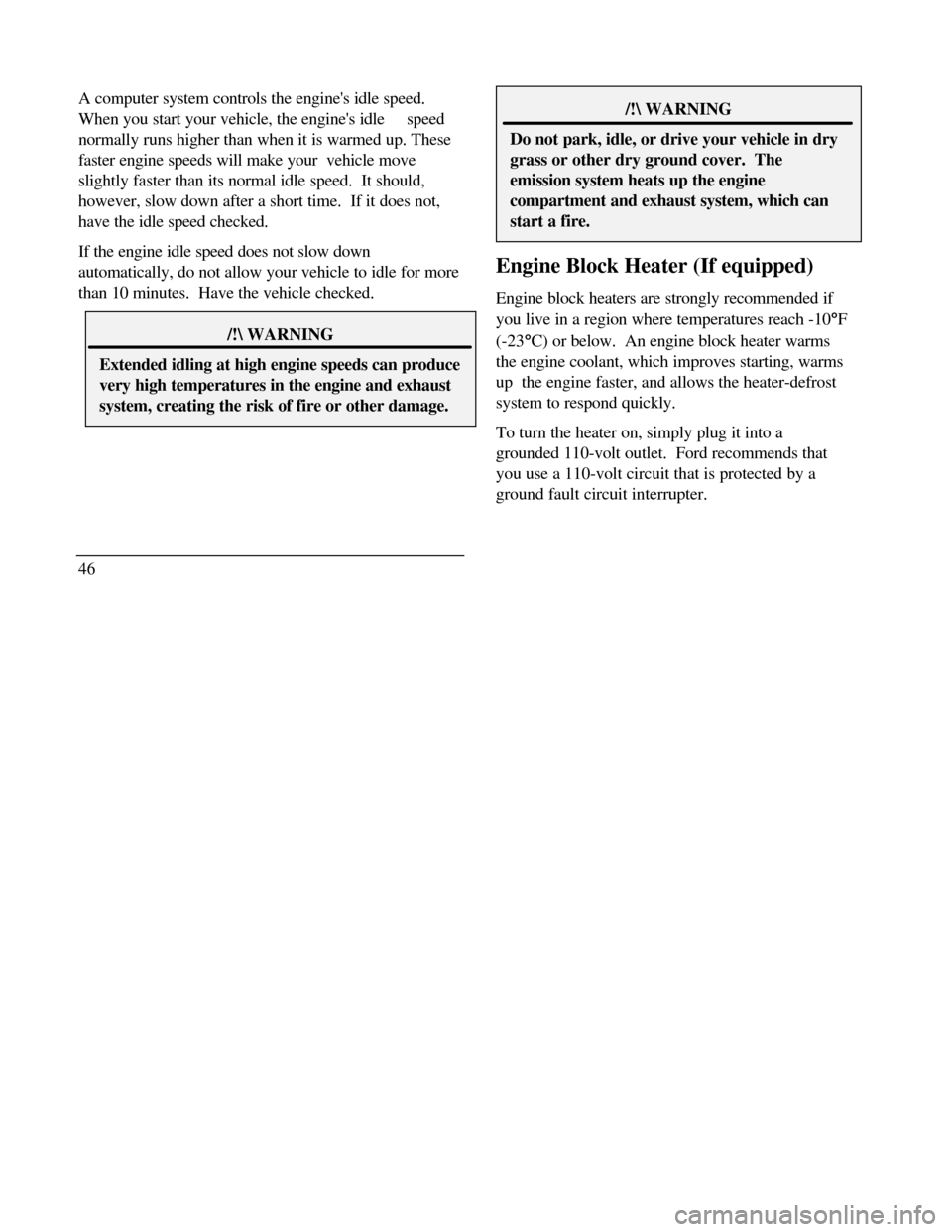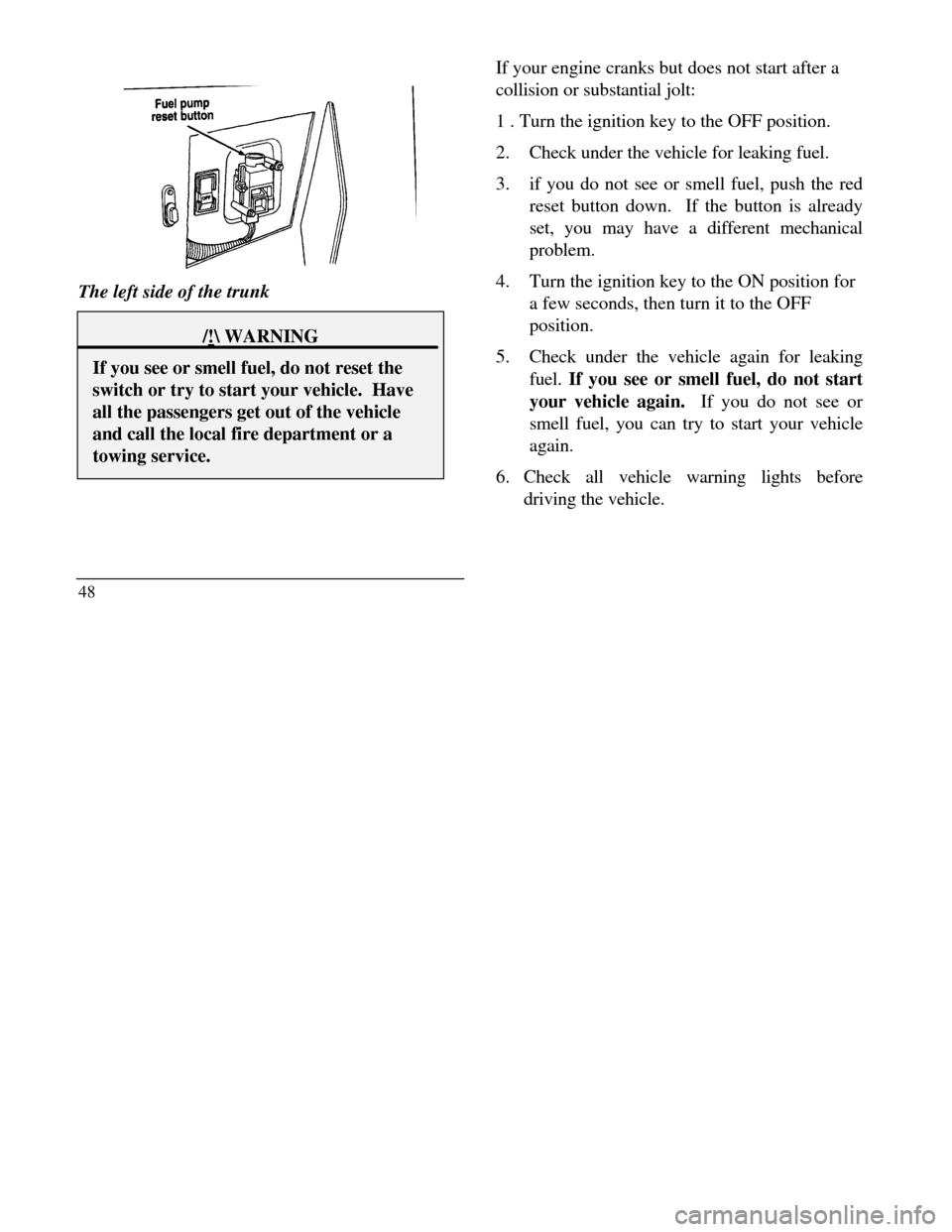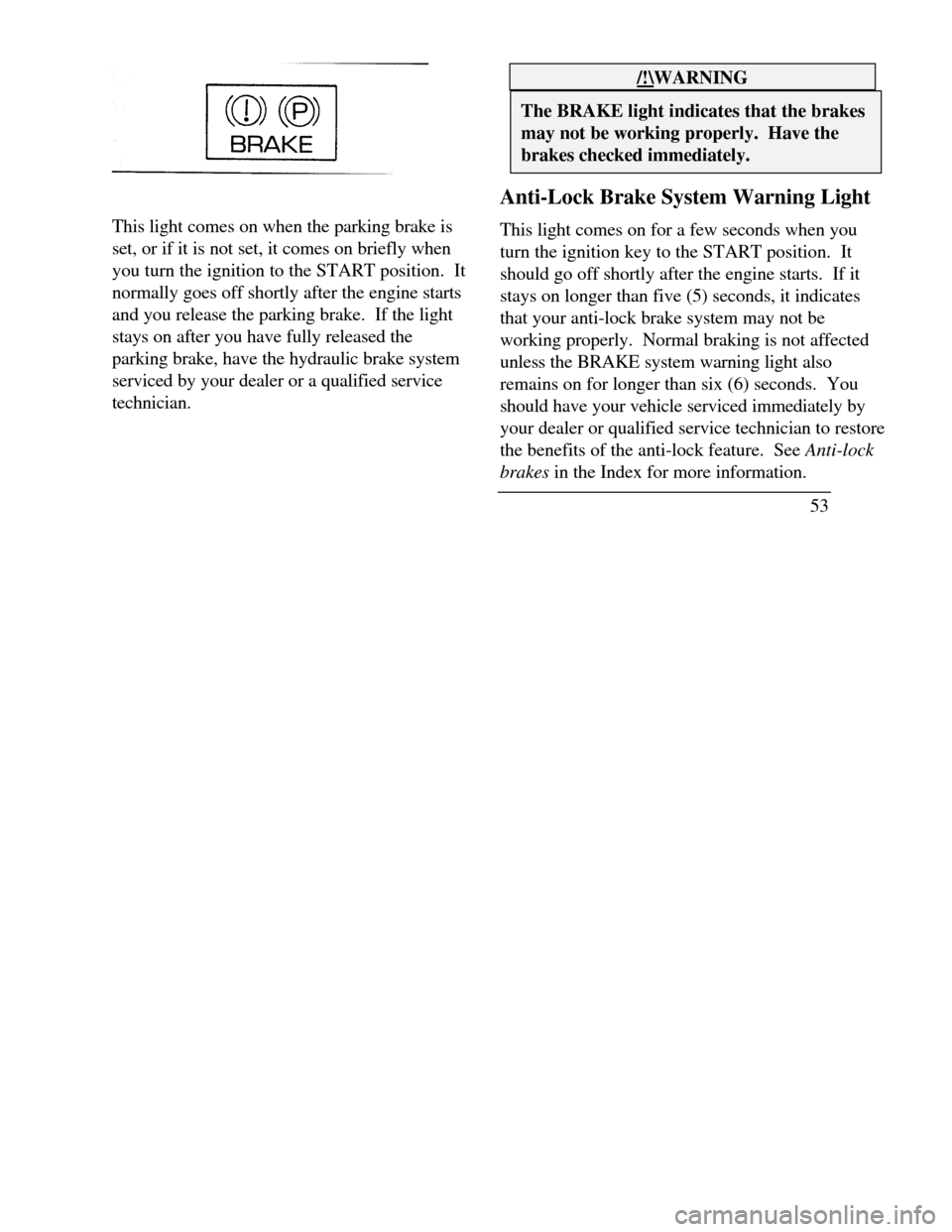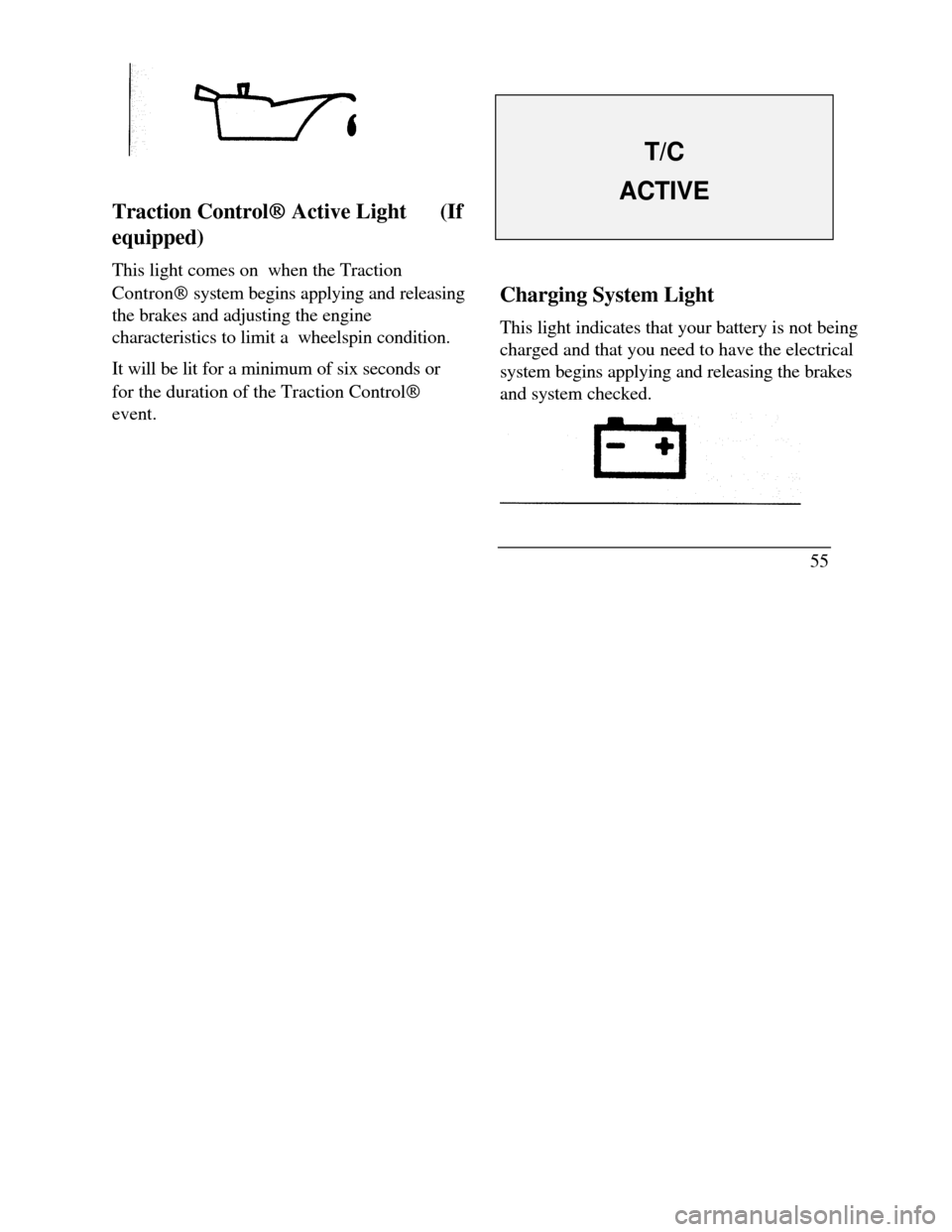check engine light LINCOLN CONTINENTAL 1996 Customer Assistance Guide
[x] Cancel search | Manufacturer: LINCOLN, Model Year: 1996, Model line: CONTINENTAL, Model: LINCOLN CONTINENTAL 1996Pages: 320, PDF Size: 1.8 MB
Page 49 of 320

A computer system controls the engine's idle speed.
When you start your vehicle, the engine's idle speed
normally runs higher than when it is warmed up. These
faster engine speeds will make your vehicle move
slightly faster than its normal idle speed. It should,
however, slow down after a short time. If it does not,
have the idle speed checked.
If the engine idle speed does not slow down
automatically, do not allow your vehicle to idle for more
than 10 minutes. Have the vehicle checked./! WARNINGExtended idling at high engine speeds can producevery high temperatures in the engine and exhaustsystem, creating the risk of fire or other damage.46/! WARNINGDo not park, idle, or drive your vehicle in drygrass or other dry ground cover. Theemission system heats up the enginecompartment and exhaust system, which canstart a fire.Engine Block Heater (If equipped)
Engine block heaters are strongly recommended if
you live in a region where temperatures reach -10° °F
(-23° °C) or below. An engine block heater warms
the engine coolant, which improves starting, warms
up the engine faster, and allows the heater-defrost
system to respond quickly.
To turn the heater on, simply plug it into a
grounded 110-volt outlet. Ford recommends that
you use a 110-volt circuit that is protected by a
ground fault circuit interrupter.
Page 51 of 320

The left side of the trunk/! WARNINGIf you see or smell fuel, do not reset theswitch or try to start your vehicle. Haveall the passengers get out of the vehicleand call the local fire department or atowing service.48If your engine cranks but does not start after a
collision or substantial jolt:
1 . Turn the ignition key to the OFF position.
2.Check under the vehicle for leaking fuel.
3.if you do not see or smell fuel, push the red
reset button down. If the button is already
set, you may have a different mechanical
problem.
4.Turn the ignition key to the ON position for
a few seconds, then turn it to the OFF
position.
5.Check under the vehicle again for leaking
fuel. If you see or smell fuel, do not start
your vehicle again. If you do not see or
smell fuel, you can try to start your vehicle
again.
6. Check all vehicle warning lights before
driving the vehicle.
Page 56 of 320

This light comes on when the parking brake is
set, or if it is not set, it comes on briefly when
you turn the ignition to the START position. It
normally goes off shortly after the engine starts
and you release the parking brake. If the light
stays on after you have fully released the
parking brake, have the hydraulic brake system
serviced by your dealer or a qualified service
technician./!\WARNINGThe BRAKE light indicates that the brakesmay not be working properly. Have thebrakes checked immediately.Anti-Lock Brake System Warning Light
This light comes on for a few seconds when you
turn the ignition key to the START position. It
should go off shortly after the engine starts. If it
stays on longer than five (5) seconds, it indicates
that your anti-lock brake system may not be
working properly. Normal braking is not affected
unless the BRAKE system warning light also
remains on for longer than six (6) seconds. You
should have your vehicle serviced immediately by
your dealer or qualified service technician to restore
the benefits of the anti-lock feature. See Anti-lock
brakes in the Index for more information.
53
Page 57 of 320

Engine Oil Pressure Warning Light
This light indicates the engine's oil pressure, not
the oil level. However, if your engine's oil level
is low, it could affect the oil pressure. The
light will come on briefly when you turn your
key to the START and ON position. The light
should stay off when the engine is running with
normal oil pressure. If the light comes on while
the engine is running, you have lost oil pressure
and continued operation will cause severe
engine damage.
54If you lose engine oil pressure:
1. Pull off the road as soon as safely possible.
2. Shut off the engine immediately or severe engine
damage could result.
3. Check the engine's oil level, following the
instructions on checking and adding engine oil,
see the Engine Oil in the Index. If you do not
follow these instructions, you or others could be
injured. To assure an accurate reading, your car
should be on level ground.
4. If the level is low, add only as much oil as
necessary before you start the engine again. Do
not overfill. Do not operate the engine if the light
is on, regardless of the oil level. Contact your
nearest dealer for further service actions.
For more information about adding oil, see Adding
engine oil in the Servicing Your Vehicle chapter.
Page 58 of 320

Traction ControlÒ Ò Active Light (If
equipped)
This light comes on when the Traction
ContronÒ system begins applying and releasing
the brakes and adjusting the engine
characteristics to limit a wheelspin condition.
It will be lit for a minimum of six seconds or
for the duration of the Traction ControlÒ
event.T/CACTIVECharging System Light
This light indicates that your battery is not being
charged and that you need to have the electrical
system begins applying and releasing the brakes
and system checked.55
Page 59 of 320

This light comes on every time you turn the
ignition to the ON or START position (engine
offl. The light should go off when the engine
starts and the alternator begins to charge.
If the light stays on or comes on when the
engine is running, have the electrical system
checked as soon as possible.
Turn Signal Indicator Lights
When you push the turn signal lever up before
making a right turn, the right side arrow on the
instrument panel flashes.
When you push the turn signal lever down
before making a left turn, the left side arrow on
the instrument panel flashes.
Usually, the turn signals turn off automatically
after you turn your car. If the turn signal
continues to flash after you have made the turn,
push the lever back to the OFF position.
56If one or both of your turn indicators do not flash
or stay on continuously, have them serviced as
soon as possible. In the meantime, be sure to use
the accepted hand signals.
Service Engine Soon Warning Light
The Powertrain On-Board Diagnostic 11
(OBD 11) system consists of the hardware
and software necessary to monitor the
operation of the powertrain. The OBD 11
system is designed to check the function
of the vehicle's powertrain control system
during normal operation. If an emission
problem is detected, the Service Engine
Soon light (in the cluster) is turned on.
Page 188 of 320

In general, this system improves your vehicle's
stability and acceleration performance when road
conditions warrant. Traction ControlÔ is fully
effective at all vehicle speeds.
If the Traction ControlÔ system is cycled
excessively, the brake portion of the system will shut
down to prevent the front brakes from overheating.
A limited Traction ControlÔ function using engine
torque will still control wheels from spinning. A
cooling down period is required to prevent damage
to the brakes. This time period varies and depends
on brake usage during the cooling down period.
Anti-Lock braking is not affected and will function
normally during the cool down period.
After the cool down period, the full Traction
ControlÔ' function is restored.Steering Your Vehicle
Your vehicle comes with power steering.
Power steering uses energy from the engine to
help steer your vehicle.
If the amount of effort needed to steer your
vehicle changes, check your steering effort
selection in the Message Center. If this is not
the problem, have the power steering system
checked. If the power steering system breaks
down (or if the engine is turned off), you can
steer the vehicle manually but it takes more
effort.
The steering system in your vehicle is speed
sensitive. This means that the steering effort is
light for parking and heavier for highway
driving. However, if you have to swerve
around an object or another vehicle, your
steering will have full power assist.
185
Page 190 of 320

Brakes
Applying the Brakes
Your vehicle has anti-lock disc brakes on all four
wheels. They adjust automatically as the brake pads
wear down.
When you press down hard on the brake pedal, the
wheels will not lock and slide. The Anti-lock Brake
System (ABS) automatically starts releasing and
reapplying the front brakes independently and the
rear brakes together whenever your wheels start to
lock. When this happens, you will feel the brake
pedal pulsate. This is an indication that the ABS
system is working correctly and is normal.
Each time you turn the ignition key to the ON
position, the anti-lock brake system will function
through one test cycle. When this happens, the ANTI-
LOCK light will come on for up to five seconds and a
clunk may be felt in the pedal. If the light stays on
longer than five seconds, shut off theengine and restart. If it remains on, it means the
anti-lock brake system is disabled and should be
serviced immediately to restore the benefits of
the anti-lock feature. Normal braking is not
affected unless the brake warning light is also lit.
The And-lock Brake System has self-check
capabilities. As described above, the system
turns on the ANTI-LOCK light each time you
start your engine. After the engine is started
and the ANTI-LOCK light turns off, the system
performs another test the first time the vehicle
reaches 14 m.p.h. (22 km/h). The system turns
on the ABS pump motor for approximately 1/2
second. At this time, a mechanical noise may
be heard. This is a normal part of the self-
check feature. If a malfunction is found during
this check the ANTI-LOCK light will come on.
Do not drive with your foot resting on the
brake pedal; you will wear out the linings and
increase your vehicle's stopping distance.
Brake rotor damage may also eventually occur.
187
Page 193 of 320

You have an automatic release for the parking brake.
The parking brake should automatically unlock when
you move the gearshift to any forward gear while the
engine is running. However, the automatic release
does not work when the gearshift is in reverse,
neutral or park.
To manually release the parking brake, pull the
BRAKE RELEASE handle located on the lower left
comer of the instrument panel. The Brake Warning
Light will illuminate if the parking brake is not fully
released when the engine is running.
The parking brake is not designed to stop a moving
vehicle, but you can use the parking brake to stop
your vehicle in an emergency if the normal brakes
fail. However, since the parking brake applies only
the rear brakes, the stopping distance will increase
greatly and the handling of your vehicle will be
adversely affected.
190Always check the Brake Warning light each
time you start your engine. Driving with the
parking brake on will cause the brakes to wear
out quickly and will reduce the fuel economy.
Driving Under Special Conditions
Tips for Safe Driving
As with any new vehicle, yours may drive and
handle differently from your previous vehicle.
Use care until you become accustomed to its
various features and driving characteristics.
Operate your vehicle within reasonable limits.
Sudden acceleration, deceleration, turning, or
combinations of these maneuvers can cause a
vehicle to behave differently than anticipated.
Page 199 of 320

Towing ClassLight-dutyMaximum gross trailer
weight1,000/2,000 lbs. (454/907
kg)*Maximum tongue load100/200 lbs. (45/91 kg)Engine4.OLHitch designLoad carrying typeTraffer-tow package
optionNot requiredVehicle speed should not exceed 45 mph (72 km/h) when
towing on grades. Limit maximum gross trailer weight to
1,000 lbs. (454 kg) and maximum tongue load to 100 lbs. (45
kg): (1) when you are towing a trailer on steep hills or on
moderate hills for a long distance (five miles (8 kms) or more)
(2) on very hot days (when the temperature is 1OO°F (38°C)
or more).
You should also limit your trailer's load when you
tow in high altitudes.
196Preparing to Tow
For your safety and for the good of your
vehicle, use the right equipment for the type of
trailer you tow. Also, make sure that all
towing equipment is properly attached to your
vehicle. If you are not certain that you are
using the right equipment in the proper manner,
see your Ford or Lincoln-Mercury dealer.
Do not use hitches that clamp onto your
vehicle's bumper. The bumper is not designed
to bear the load.
Always check the pressure in all your vehicle's
tires when preparing to tow (see inflation
recommendation on the tire label).
Connecting the safety chains
Always attach the trailer's safety chains to your
vehicle. They help protect your trailer if the
hitch breaks.